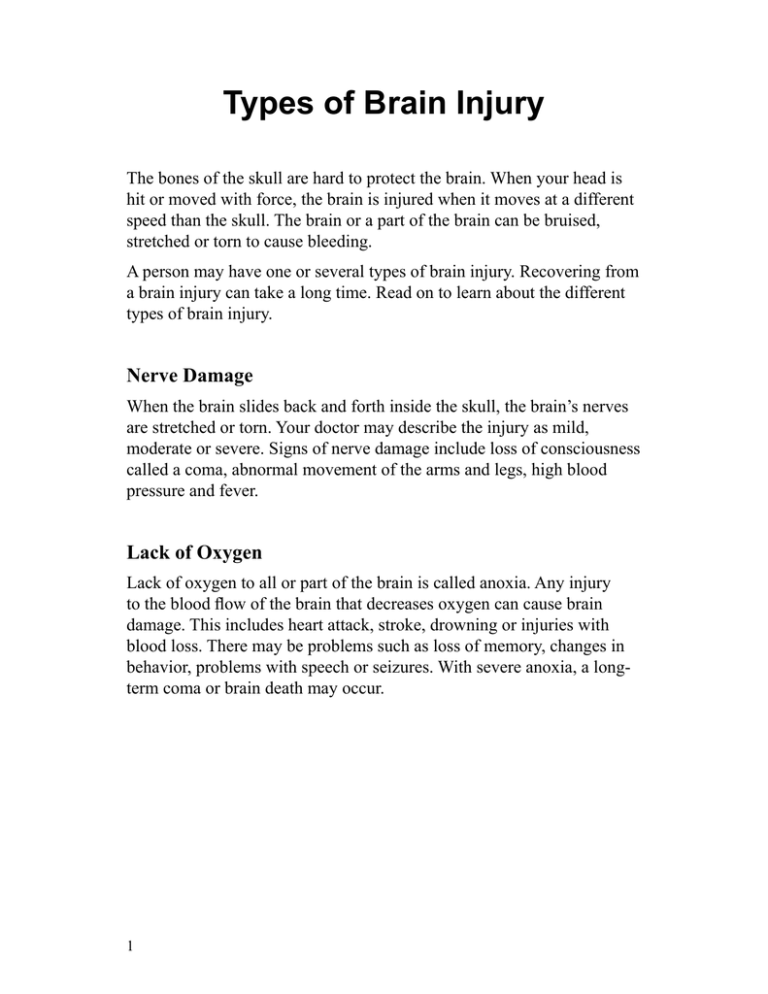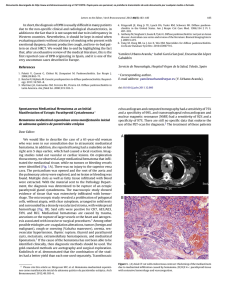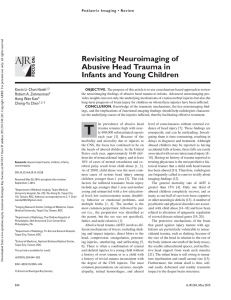Types of Brain Injury - Spanish - Health Information Translations
Anuncio

Types of Brain Injury The bones of the skull are hard to protect the brain. When your head is hit or moved with force, the brain is injured when it moves at a different speed than the skull. The brain or a part of the brain can be bruised, stretched or torn to cause bleeding. A person may have one or several types of brain injury. Recovering from a brain injury can take a long time. Read on to learn about the different types of brain injury. Nerve Damage When the brain slides back and forth inside the skull, the brain’s nerves are stretched or torn. Your doctor may describe the injury as mild, moderate or severe. Signs of nerve damage include loss of consciousness called a coma, abnormal movement of the arms and legs, high blood pressure and fever. Lack of Oxygen Lack of oxygen to all or part of the brain is called anoxia. Any injury to the blood flow of the brain that decreases oxygen can cause brain damage. This includes heart attack, stroke, drowning or injuries with blood loss. There may be problems such as loss of memory, changes in behavior, problems with speech or seizures. With severe anoxia, a longterm coma or brain death may occur. 1 Tipos de lesión cerebral Los huesos del cráneo son duros para proteger al cerebro. Cuando se golpea o se mueve con fuerza la cabeza, el cerebro resulta lastimado cuando se mueve a una velocidad distinta a la del cráneo. El cerebro o una parte de éste pueden verse afectados por moretones, tirones o desgarros que provoquen sangrado. Una persona puede sufrir uno o varios tipos de lesiones cerebrales. Recuperarse de una lesión cerebral puede tardar mucho tiempo. Siga leyendo para informarse sobre los distintos tipos de lesión cerebral. Daño a los nervios Cuando el cerebro se desliza hacia delante y hacia atrás dentro del cráneo, los nervios del cerebro se ven afectados por tirones o desgarros. El médico puede describir la lesión como leve, moderada o grave. Los signos de daño a los nervios incluyen pérdida de la conciencia, llamada coma, movimiento anormal de los brazos y piernas, presión arterial alta y fiebre. Falta de oxígeno La falta de oxígeno en el cerebro, ya sea de forma total o parcial, se denomina anoxia. Cualquier daño al flujo de sangre al cerebro que disminuya el oxígeno puede provocar daño cerebral. Esto incluye ataque cardíaco, derrame cerebral, ahogos o lesiones con pérdida de sangre. Puede que se produzcan problemas como pérdida de memoria, cambios en el comportamiento, problemas con el habla o convulsiones. Con anoxia grave, se puede producir un coma a largo plazo o la muerte cerebral. Types of Brain Injury. Spanish. 1 Bruising Bruising Bruising or contusion can occur when the head is hit and the brain moves back and forth inside the skull. Bleeding inside the brain or skull fractures may also occur. Bruising can cause brain swelling, coma, seizures, brain damage or higher pressure inside the skull. Hematoma A hematoma is a pool or lump of blood. There are 3 types of hematomas based on where the blood pools. Force of Hit Epidural Hematoma Subdural Hematoma • Epidural hematoma – the outer layer of the brain between the brain and skull. • Subdural hematoma – the middle layer of the brain. • Intracerebral hematoma – the inside part of the brain. Hematomas can cause brain swelling, high pressure inside the skull or coma. Surgery may be done to remove the hematoma. This depends on where the hematoma is and whether it is getting larger or causing problems. Hematoma may not cause any lasting effects, but other brain injuries may occur with the hematoma. 2 Intracerebral Hematoma Contusión Hematomas Se pueden producir moretones o contusiones cuando se golpea la cabeza y el cerebro se mueve hacia adelante y hacia atrás dentro del cráneo. También se puede producir un sangrado dentro del cerebro o fracturas en el cráneo. Las contusiones pueden producir inflamación cerebral, coma, convulsiones, daño cerebral o mayor presión dentro del cráneo. Fuerza del impacto Hematoma Un hematoma es un bulto o acumulación de sangre. Existen 3 tipos de hematomas, dependiendo de la zona donde esté la acumulación de sangre. Hematoma epidural Hematoma subdural • Hematoma epidural: está en la capa más externa del cerebro, entre el cerebro y el cráneo. Hematoma intracerebral • Hematoma subdural: está en la capa media del cerebro. • Hematoma intracerebral: está en la parte interna del cerebro. Los hematomas pueden causar inflamación cerebral, presión alta dentro del cráneo o coma. Puede que se realice una cirugía para extraer el hematoma. Esto depende de la ubicación del hematoma y de si está creciendo o causando problemas. Puede que el hematoma no provoque efectos permanentes, pero se pueden producir otras lesiones cerebrales junto con éste. Types of Brain Injury. Spanish. 2 Cerebral Hemorrhage Cerebral hemorrhage is bleeding in the brain. Bleeding can occur in 3 areas of the brain: • Over the outer surface of the brain called subarachnoid hemorrhage. Intracerebral Hemorrhage • Into the spaces of the brain or ventricles called intraventricular hemorrhage. Skull Subarachnoid Hemorrhage Intraventricular Hemorrhage • Into the brain tissue called intracerebral hemorrhage. Your Care Treatment for a brain injury may include surgery and medicines. Rehab or therapy may be needed over time to help manage problems. Recovery will depend on how severe the brain injury was. Talk to your doctor or nurse if you have any questions or concerns. 2005 – 1/2011 Health Information Translations Unless otherwise stated, user may print or download information from www.healthinfotranslations.org for personal, non-commercial use only. The medical information found on this website should not be used in place of a consultation with your doctor or other health care provider. You should always seek the advice of your doctor or other qualified health care provider before you start or stop any treatment or with any questions you may have about a medical condition. The Ohio State University Medical Center, Mount Carmel Health System, OhioHealth and Nationwide Children’s Hospital are not responsible for injuries or damages you may incur as a result of your stopping medical treatment or your failure to obtain medical treatment. 3 Hemorragia cerebral La hemorragia cerebral es sangrado en el cerebro. Se puede producir sangrado en 3 áreas del cerebro: • Sobre la superficie externa del cerebro llamada hemorragia subaracnoidea. Hemorragia intracerebral Cráneo • En los espacios del cerebro o ventrículos llamada hemorragia intraventricular. Hemorragia subaracnoidea Hemorragia intraventricular • En el tejido cerebral, llamada hemorragia intracerebral. Cuidados El tratamiento para una lesión cerebral puede incluir cirugía y medicamentos. Es posible que con el transcurso del tiempo se requiera rehabilitación o terapia para ayudar a solucionar los problemas. La recuperación dependerá de la gravedad de la lesión cerebral. Hable con su médico o enfermera si tiene alguna pregunta o duda. 2005 – 1/2011 Health Information Translations Unless otherwise stated, user may print or download information from www.healthinfotranslations.org for personal, non-commercial use only. The medical information found on this website should not be used in place of a consultation with your doctor or other health care provider. You should always seek the advice of your doctor or other qualified health care provider before you start or stop any treatment or with any questions you may have about a medical condition. The Ohio State University Medical Center, Mount Carmel Health System, OhioHealth and Nationwide Children’s Hospital are not responsible for injuries or damages you may incur as a result of your stopping medical treatment or your failure to obtain medical treatment. Types of Brain Injury. Spanish. 3




